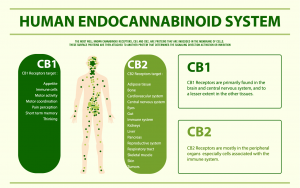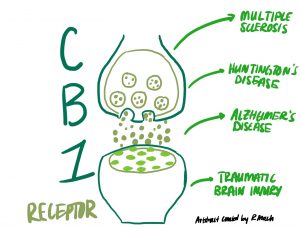The endocannabinoid system (ECS) has proven itself to be a vital player in many central nervous system functions, potentially serving as a new therapeutic mechanism for many neurodegenerative disorders such as multiple sclerosis (MS), Huntington’s disease (HD), Alzheimer’s disease (AD), and traumatic brain injury (TBI). There is currently a movement towards uncovering more information about this relatively new system, with considerable research being conducted on the ECS. Because of this additional research, we know more about the ECS than ever before. Let’s dive into more of the details of this incredibly powerful system.
ENDOCANNABINOIDS & THEIR RECEPTORS
The endocannabinoid system has two receptors named CB1 and CB2. Both of these serve vital roles, but they are certainly different. The CB1 receptor is highly abundant throughout the central nervous system (CNS), with particularly high levels in the neocortex, hippocampus, basal ganglia, cerebellum, and brainstem. The CB1 receptor binds THC, the active ingredient in marijuana (that many of us have likely heard of). The CB2 receptor is involved most predominantly in the immune system, allowing them to control synaptic function and be involved in synaptic plasticity in response to drugs of abuse. These two receptors work independently to modulate inhibitory plasticity, but both serve important roles in the overall functioning of the ECS.
The molecules that bind to these receptors are just as important as the receptors themselves. They are called endocannabinoids, and our bodies naturally make these molecules in order to activate the ECS receptors. The two most well-known endocannabinoids are anandamide (AEA) and 2-arachidonoylglycerol (2-AG). They are synthesized on-demand, and thus they have a short window of activity before they are broken down by an enzyme. Interestingly, both of these molecules bind the CB1 receptors with higher affinity than the CB2 receptors.
IN THE BODY
Now that we have some background information on the receptors of the ECS, it’s time to look more deeply into what they are doing in the body—specifically, in the central nervous system. The ECS has widespread roles identified, such as in mood regulation, pain perception, and learning and memory, for example. A unique component of endocannabinoids is that they are retrograde messengers: they send their signals “backwards!” Activation of the CB1 receptor causes changes in potassium ion flow and decreases in calcium ion channel conductance. Interestingly, it also means less endocannabinoid production. Because of these inhibitory effects, there is a decrease of neurotransmitter release seen after activation of the ECS, which is why the ECS plays such a crucial role in mediating synaptic plasticity.
ROLE IN NEURODEGENERATIVE DISEASES
 We’ve looked more deeply into how the endocannabinoid system works in our body, but it’s also important to highlight the roles it has in CNS disorders, specifically in MS, HD, AD, and TBI. For multiple sclerosis, endocannabinoids have already been identified as effective treatment options for muscle spasms and pain. It is thought that this is due to an increased activation of both CB1 and CB2 receptors by agonists at the molecular level. The increased activation leads to the dual-inflammatory and neuroprotective effects of endocannabinoids. Because receptor agonists have therapeutic effects, it is hypothesized that CB1 and CB2 may be impaired in patients with MS, eliminating their neuroprotective roles.
We’ve looked more deeply into how the endocannabinoid system works in our body, but it’s also important to highlight the roles it has in CNS disorders, specifically in MS, HD, AD, and TBI. For multiple sclerosis, endocannabinoids have already been identified as effective treatment options for muscle spasms and pain. It is thought that this is due to an increased activation of both CB1 and CB2 receptors by agonists at the molecular level. The increased activation leads to the dual-inflammatory and neuroprotective effects of endocannabinoids. Because receptor agonists have therapeutic effects, it is hypothesized that CB1 and CB2 may be impaired in patients with MS, eliminating their neuroprotective roles.
For Huntington’s, there is a reduced expression of the CB1 receptor, resulting in decreased motor performance. CB1 receptors importantly activate growth factors, so when there is a decrease in receptors, the patient won’t have enough growth factor expression.
The main takeaway in Alzheimer’s is that the ECS receptors could have anti-inflammatory effects, leading to lower levels of amyloid-beta plaques and neurofibrillary tangles. This means that the ECS could be an effective treatment method in reducing those inflammatory issues seen in AD. Also noteworthy, CBD has been shown to reduce Tau protein phosphorylation, which would also be an effective treatment for AD patients.
Finally, in traumatic brain injury, it is hypothesized that 2-AG levels increase following the injury, and the signal to synthesize more endocannabinoids has been shown to reduce brain inflammation. CB1 and CB2 receptor agonists have also been known to demonstrate neuroprotection, so this would be effective in treating TBI as well.
It is clear that the endocannabinoid system is wildly important, and I’m sure our knowledge will only continue to grow on the subject – who knows what else we’ll discover about the ECS!
